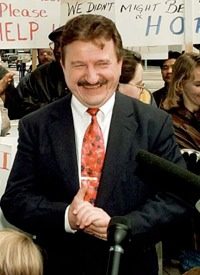
In 1997, The New American magazine ran an in-depth article about the doctor, his alternative therapy, and the almost unbelievable campaign of persecution waged by the Food and Drug Administration (FDA). Now, it’s all recounted in a powerful documentary called Burzynski, the Movie — Cancer Is Serious Business, available for free online until June 20.
The Burzynski saga really begins in the late 1960s, when the young doctor was working on his biochemistry dissertation in Poland. During his research, he identified a previously undocumented strain of natural peptides in human blood and urine. It was enough to spark his interest.
Dr. Burzynski then realized something even more important: Cancer patients seemed to have lower levels of the peptides than healthy people. Eventually, after studying the protein fragments further, he concluded that they actually play a role in controlling the disease. So he called them “antineoplastons” and set up shop in Texas.
After decades of treating thousands of seemingly hopeless cancer patients, Dr. Burzynski has now succeeded in convincing a great number of other doctors and experts about the value of his discovery. That’s where the documentary begins.
The first 30 minutes or so sets out to establish the success of Dr. Burzynski’s antineoplaston therapy — particularly when measured against the outcomes of traditional cancer treatments like chemotherapy, radiation, and surgery. The segment features interviews with some of Dr. Burzynski’s patients and their families, medical data on the efficacy of his approach, testimony from other medical professionals, and more.
“I was astounded,” notes long-time supporter Dr. Julian Whitaker in an interview. “Dr. Burzynski had MRIs of brain tumors, known to be almost universally fatal, that had simply disappeared. It was obvious to me that Dr. Burzynski had made the most important discovery in cancer treatment — ever. It’s what we have been looking for.”
A lot of cancer patients treated with antineoplastons offer similarly glowing reviews throughout the film. So do their families. But then the story begins to turn ugly.
When Dr. Burzynski fled to America from communist Poland in 1970, he was hoping to find freedom to carry on his work. Advancing and conducting serious research back home after refusing to join the Communist Party was quite difficult, to say the least. Unfortunately, Dr. Burzynski never could have imagined that he would endure more government tyranny at the hands of the U.S. “justice” system than he ever had in his native land.
But before going in to the real battle, the documentary highlights some astounding facts and figures. The U.S. government’s National Cancer Institute has an annual unconstitutional budget of more than $5 billion. Much of that money is showered on giant pharmaceutical companies, which have so far failed miserably in terms of treating and curing cancer.
Meanwhile, Dr. Burzynski, who according to the data provided in the film has successfully treated nearly every form of the disease, does not receive a single cent. And because the regulatory red tape requires many millions of dollars to successfully navigate, just conducting clinical trials has been quite a mission. But that’s just the beginning.
Dr. Burzynski, his patients, and supportive scientists and doctors have been trying to get the FDA to cooperate in testing and approving the use of antineoplastons since 1977, when he set up his independent practice in Texas. Instead, the agency decided to wage a ruthless and costly campaign in an effort to bury Dr. Burzynski and his treatment.
The persecution started in the mid 1980s with the Texas Board of Medical Examiners, which attempted to revoke Dr. Burzynski’s license to practice medicine. They failed. But the years of state-level harassment, investigations, and court proceedings — which were eventually discovered to be the result of pressure from the FDA — were only the start of the doctor‘s problems with authorities.
Next came the open assault by the federal government. First the FDA filed a civil lawsuit against Dr. Burzynski trying to shut down his clinic and prevent his patients from receiving their medicine. The agency warned the judge that if the court would not grant the injunction it was seeking, the federal government would be forced to use “less efficient” methods to shut down Dr. Burzynski — methods like propaganda, raids, and even criminal prosecution.
After failing to squash Dr. Burzynski in civil court, the feds took their war to the next level. The first grand jury was convened in 1985 in an effort to get an indictment. As part of the new strategy, the FDA raided Dr. Burzynski’s clinic and seized all of his patients’ medical records. They failed to get an indictment.
The next year, prosecutors seized more “evidence.” Still no indictment. In 1990, yet another grand jury was convened. And once again, it refused to indict. Then another grand jury. No indictment. And then another. At no point did the FDA claim that antineoplastons were not safe or effective.
After failing to get an indictment with at least five grand juries, however, the federal government and the cancer industry were really getting frustrated. The FDA began issuing subpoenas to anyone and everyone associated with Dr. Burzynski: other doctors, patients, and even journalists who had written favorably about Dr. Burzynski and his work. Finally, in 1995, Congress stepped in.
“In my opinion, you have every right to use the investigative authority and the judicial resources of the federal government to the justice department convene a grand jury, that’s very appropriate, the first time, perhaps even the second time,” Rep. Joe Barton told the FDA Commissioner during a hearing of the House Oversight and Investigations Subcommittee shown in the documentary. “It becomes questionable the third time. The fourth time and the fifth time, it is not, I think, an illogical conclusion to think that the FDA has a vendetta against Dr. Burzynski, or wants to retaliate for some reason.”
FDA boss David Kessler appeared uncomfortable. But Rep. Barton kept piling it on: “How many grand jury investigations have to occur that result in no finding of fault before you as commissioner of the FDA would encourage those within your organization to cease and desist?” Kessler never did answer the question.
Then another Congressman at the hearing chimed in. After confirming that there had indeed been at least four unsuccessful attempts to get a grand-jury indictment, the committee member says: “I am left then, with rather strong inference, that if you convene four separate grand juries and there is no indictment returned — not withstanding that prosecutors tell us always that it’s possible to indict a ham sandwich — that probably there’s not much there.”
A lot of Dr. Burzynski’s patients testified at the hearing, too. “What the classical conventional medicine had to do for me was there — nothing,” noted an obviously distraught middle-aged man who had been treated with antineoplastons. “For me, the next thing was the minister. I did not want to undergo chemotherapy — which I had a new name for, ‘kill ‘em therapy’ — or any type of radiation.”
He also praised Dr. Burzynski and blasted the FDA. “I was extremely lucky that I found Dr. Burzynski. And I don’t want the FDA to take this right from me,” he said. “I came eighteen years ago from Communist Romania, and the tyrant dictator Ceauscescu never stopped a doctor from treating anybody. How can we have something like this in the United States?”
Similar stories of hope and outrage abound. In an interview with TNA for the 1997 piece, Jack Kunnari also shared his family’s tale. Kunnari’s young son Dustin was diagnosed with a type of brain cancer that is normally fatal within a few months. But six weeks after the boy began antineoplaston treatment under Dr. Burzynski, brain scans showed the tumor was completely gone. When it reappeared a year later, the dosage was increased, and the tumor once again receded. By mid 1997, it was still in remission — all with no harmful side effects.
“Initially, your son has a brain tumor, so you’re down and feeling pretty bad about things,” Kunnari told TNA’s Robert Lee. “Then you find out about this doctor and you get a feeling of hope; the MRI looks good, and your hope increases. And then the government steps in and says you can’t have the treatment.” Needless to say, the Kunnari family stood by Dr. Burzynski during his battle against the government.
Other patients and family members offered similarly moving testimony throughout the 1995 congressional hearing excerpted in the documentary. But the FDA remained unmoved. And about a week later, it finally got the indictment it was seeking.
The jury, however, refused to convict. And yet again — despite having already squandered an estimated $60 million in taxpayer money on the trial — the FDA refused to back down.
The battle continued to rage. But finally, after a second trial, Dr. Burzynski was acquitted of all charges. Eventually the FDA even granted him proper permission to provide his medicine to patients in clinical trials.
Today, Dr. Burzynski’s battles continue — trying to bring his medicine to the international market is tough with the overpowering bureaucracy and the trillion-dollar cancer industry fighting it every step along the way. But for now, it appears that he won’t be risking several lifetimes in prison just for operating his business and providing his medicine to willing patients.
More and more people are learning about it, too. The documentary had already been viewed by almost 400,000 people just a few days after being made available for free online. And it’s receiving widespread praise from other reviewers.
“It’s an absolute jaw-dropper,” wrote Dr. Joseph Mercola, who runs a website dealing with health freedom and other topics. “For anyone who has ever been affected by cancer, either directly or indirectly, the facts presented in this film will hit you like a rude slap in the face.”
Photo of Dr. Stanislaw Burzynski: AP Images



